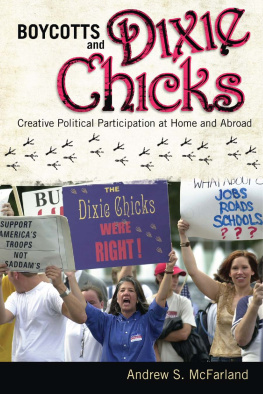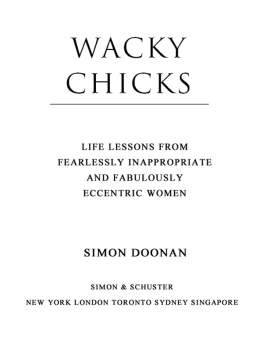First published 2011 by Paradigm Publishers
Published 2016 by Routledge
2 Park Square, Milton Park, Abingdon, Oxon OX14 4RN
711 Third Avenue, New York, NY 10017, USA
Routledge is an imprint of the Taylor & Francis Group, an informa business
Copyright 2011, Taylor & Francis.
All rights reserved. No part of this book may be reprinted or reproduced or utilised in any form or by any electronic, mechanical, or other means, now known or hereafter invented, including photocopying and recording, or in any information storage or retrieval system, without permission in writing from the publishers.
Notice:
Product or corporate names may be trademarks or registered trademarks, and are used only for identification and explanation without intent to infringe.
Library of Congress Cataloging-in-Publication Data
McFarland, Andrew S., 1940
Boycotts and Dixie Chicks: creative political participation at home and abroad / by Andrew S. McFarland.
p. cm.
Includes bibliographical references and index.
ISBN 978-1-59451-819-5 (hardcover: alk. paper)
ISBN 978-1-59451-820-1 (pbk.: alk. paper)
1. Political participation. I. Title.
JF799.M34 2010
323'.042dc22
2010000841
Designed and Typeset by Straight Creek Bookmakers.
ISBN 13: 978-1-59451-819-5 (hbk)
ISBN 13: 978-1-59451-820-1 (pbk)
My concern for creative political participation grows out of my previous concern for the study of public-interest lobbying in Washington, D.C. From 1968 to 1975 especially, new environmental and political reform lobbies appeared in the nation's capital to an almost startling degree. This was apparently an important new political phenomenon, which Jeffrey Berry and I were among the first to study. From 1974 to 1985, I spent about half my time in Washington, learning about the policy process, interviewing public-interest-group participants, and having discussions with other scholars with similar goals in Washington. Subsequently, I published three volumes about public-interest groups: Public Interest Lobbies: Decision Making on Energy (1976), Common Cause: Lobbying in the Public Interest (1984), and Cooperative Pluralism: The National Coal Policy Experiment (1993), the latter about negotiations among environmentalists and coal-industry executives.
While I strove to maintain academic objectivity, I did conclude that public-interest lobbies play an important role in the American constitutional order as a means to represent the widely diffused interests in a clean environment and in the elimination of corrupt government practices. Many political scientists and lawyers might prefer to rely on the law and the state to control pollution and political corruption, but I believe that political pressure must bolster legal practice to balance the power of economic-producer interests within a capitalist system. However, while writing these three books, I concluded that environmental lobbies and Common Cause will have continuing and substantial influence, and so my concerns shifted to the identification and prescription of other means to represent dispersed public interests. (I, of course, with enthusiasm support student participation in presidential and legislative election campaigns.)
Public-interest lobbies are a vital supplement to voting, campaigning, and the mechanisms of civic engagement. The concern for civic engagement has recently been a dominant research and intellectual trend in political science, following Robert Putnam's brilliant book Bowling Alone: The Collapse and Revival of American Community (2000). Civic engagement focuses on continuing face-to-face interaction among people who thereby learn to trust one another and to build "social capital" as a basis for enhancing cooperation for joint action. Robert Putnam and Theda Skocpol, among others, have found a decline in civic engagement in America since the 1950s. Unfortunately for the reputation of public-interest lobbies, both Putnam and Skocpol find that they are not based on civic engagement but constitute part of the decline in American community in that they consist of elite managers and lobbyists located in Washington, dependent upon checkbook contributors, most of whom never meet in a face-to-face manner. My research is cited as one basis for such observations.
I reacted to the Putnam and Skocpol allegations of public-interest elitism with the belief that while a major contribution to democratic theory, civic-engagement theory does not state everything we need to know about democratic political participation. In particular, I concluded that political participation is a concept similar in structure to political representation, as analyzed by Hanna Fenichel Pitkin in her landmark book The Concept of Representation (1967). Pitkin argued that there are separable concepts of representation and that political scientists should be aware of how they use the different types of representation and the functions of each. For instance, a subordinate may represent his boss (one type); a governing committee may be concerned with descriptive representation, that is, the committee membership being proportional to group membership in terms of categories such as sex or race (a second type); King George I of England (1714 to 1727) was a symbolic representative of England (a third type), even though descriptively he was a German. My argument is that similar considerations hold for the concept of political participation and that Putnam and Skocpol are studying one type of participation, while I have been studying another. Scholars must be clear about such distinctions and about the functions of the various types of political participation. Apparently I am a pioneer in applying Pitkin's argument about representation to participation, which is likely this book's major academic contribution.
I set forth this argument in a conference paper and sent it to my colleague Michele Micheletti in Sweden, who had been researching consumer boycotts against business, which I saw as one of the sorts of political participation I had called "creative participation." Michele suggested that we edit a book with chapters presenting still other forms of creative participation. Paradigm Publishers has just published that book, Creative Participation: Responsibility-Taking in a Political World (2010). Half the authors are European, and half are American.
Meanwhile I decided to expand my original paper into a short book, which would present examples of creative participation in four categories. First, the environment: This category reflects my research into the organization of public-interest lobbies and my opinion that the 200 (of 250) owners of condos in my building, following recycling practices, constitute a form of political participation (100 trips to the recycling bins per year, at 4 minutes each, times 200, constitutes 80,000 minutes of donated time). Second, political corruption: Having spent four weeks traveling in China, I focused on the importance of this country and noted that the 700 million rural Chinese are constantly protesting local-level corruption in spontaneous political action. Chinese rural protest struck me as having something in common with the 1890s communitywide anticorruption protests in the state of Wisconsin, an important predecessor to Robert La Follette's brand of Progressive reform. Third, political consumerism: A number of European political scientists have written about consumer protest using boycotts and other means, not relying upon government, to influence corporate practices. Political consumerism is also an American phenomenon, but up to now, there has been little social science writing in America about this type of creative participation. In my view, this lack of research is largely due to male (and possibly feminist) prejudice against housewives, who are not seen as having political potential. How many political scientists read the food pages in the New York Times ? (I don't either.) To demonstrate political consumerism as worthy of serious study, I invited my graduate student, Catherine Griffiths, to demonstrate in an exploratory treatment that consumerism can be a serious topic for quantitative study as illustrated by survey data and graphical presentation. Fourth, globalization: Globalization is now a clich; yet, it is absolutely true that citizens are increasingly motivated to public action when the entire planet is the frame of reference rather than just their own country. We can no longer restrict examination of interest groups and political participation to considering public action within just one single country.








